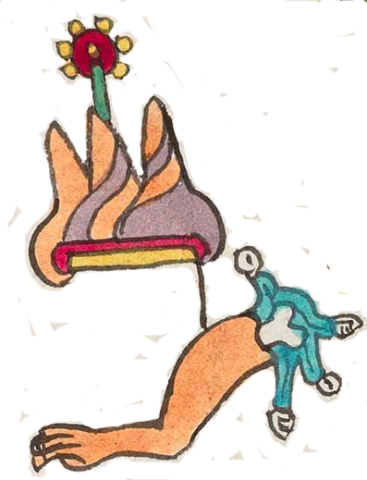Acolhuacan (Mdz5v)
This compound glyph for the place name Acolhuacan is really like two compounds connected by a line. The upper part, on the left, is a hill or mountain with three peaks. It has the wavy, alternating purple and orange coloring that stones (tetl) have in the Codex Mendoza. The bottom of the hill has the typical, parallel red and yellow lines. Above the middle peak is a flower with a green stem, a red center with a yellow dot, and small yellow circles around the circumference of the red circle. Lower, and slightly to the right, is the other part of this compound glyph. It has an arm with the (right) hand on the left and a white bone protruding on at the point of the shoulder (acolli, or ahcōlli). Turquoise blue water (ātlI, with its typical lines of current and turbinate shells and droplets (or beads, such as chalchihuites, in Hispanized Nahuatl) splashing off the flow) also comes out of the top of the arm, surrounding the bone. The locative suffix -cān is not shown visually.
Stephanie Wood
Acolhuacan is the "Place of the Ācolhua" (possibly comprised of water, ātl, and bend, cōlli, and the possessor suffix, -huah. The Acolhua are an ethnic group associated with the area of Tetzcoco, hence the overlapping glyphs between Acolhuacan and Tetzcoco. This version of the place name Acolhuacan (on folio 5 verso of the Codex Mendoza) is somewhat different from the other one on folio 21 verso. This one is very similar to the compound glyph for Tetzcoco from folio 3 verso, below on the right. In the Acolhuacan glyph pictured here, the shoulder, acōlli, has fewer color codes or adornments than other Acolhuacan glyphs or the Tetzcoco glyph from the Codex Mendoza. The water, ātl, colored turquoise again here, does protrude near the shoulder bone, in a similar fashion to the other one. The main difference between Acolhuacan on 21v and on 5v is the presence of the attached mountain, tepetl, with three peaks, as though divided by ravines (atlauhtli), and decorated with stone symbols (tetl). Karttunen suggests the twisted lines on the hill are meant to provide the phonetic -cōl (twisted). She also points out that the hill or mountain symbol (tepetl) can stand for town (altepetl), but probably not in this case, given the multiple peaks and wavy lines. A yellow and red flower with a green stem emerges atop the middle of the three peaks. None of these signs are part of the compound glyph for Acolhuacan on folio 21 verso, but the flower does echo the same element in the compound sign for Tetzcoco, although the latter has two flowers, one above each ravine.
Stephanie Wood
acolhuacā. puo
Acolhuacan, pueblo
Stephanie Wood
c. 1541, or by 1553 at the latest
Stephanie Wood
This glyph is two in one, but only the lower one is read for Acolhuacan. That one is both downward and right to left.
peaks, mountains, flowers, shoulders, bones, ravines, water, arms, hills, nombres de lugares, hueso, huesos

a(tl) or ātl, water, https://nahuatl.wired-humanities.org/content/atl
acol(li) or ahcōlli, shoulder, https://nahuatl.wired-humanities.org/content/acolli
coltic, curved, https://nahuatl.wired-humanities.org/content/coltic
coloa or cōloa, to bend or twist. https://nahuatl.wired-humanities.org/content/coloa
-hua- or -huah (possessor suffix), https://nahuatl.wired-humanities.org/content/hua
-can (locative suffix), https://nahuatl.wired-humanities.org/content/can-2
tepe(tl), hill or mountain, https://nahuatl.wired-humanities.org/content/tepetl
atlauh(tli), ravine, https://nahuatl.wired-humanities.org/content/atlauhtli
xochi(tl), flower, https://nahuatl.wired-humanities.org/content/xochitl
ma(itl), hand or arm, https://nahuatl.wired-humanities.org/content/maitl
"Place of the Acolhua" (Berdan and Anawalt, and also supported by Frances Karttunen. Karttunen adds that the vowel length and glottal stops are not shown visually in hieroglyphs. [Frances Karttunen, unpublished manuscript, used here with her permission.]
"Place of the Acolhua" (Berdan and Anawalt, 1992, vol. 1, p. 169)
"El Lugar de los Acolhua"
Stephanie Wood
Codex Mendoza, folio 5 verso, https://digital.bodleian.ox.ac.uk/objects/2fea788e-2aa2-4f08-b6d9-648c00..., image 21 of 188.
The Bodleian Libraries, University of Oxford, hold the original manuscript, the MS. Arch. Selden. A. 1. This image is published here under the UK Creative Commons, “Attribution-NonCommercial-ShareAlike 3.0 License” (CC-BY-NC-SA 3.0).





